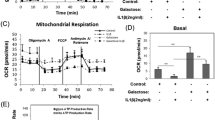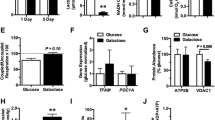Abstract
Articular cartilage proteoglycan biosynthesis was substantially inhibited by the competitive glycolytic inhibitor 2-deoxyglucose (∼65% at 100 mM), but to a much lesser degree (∼10%) by the oxidative phosphorylation uncoupler, 2,4-dinitrophenol. These results confirm that articular cartilage proteoglycan synthesis mostly utilises ATP which is generated by glycolysis. In addition, we have utilised the loss of the relatively specific labelling of glyceraldehyde-3-phosphate dehydrogenase (G3PDH) by [3H]-iodoacetic acid to show that rabbit articular G3PDH is oxidisedin vivo during the animal model of acute arthritis, carrageenin-induced arthritis, in the same way as we have previously shown that cartilage G3PDH is oxidised afterin vitro exposure to sublethal doses of H2O2. The oxidation of rabbit G3PDHin vivo (18 hr post-injection) corresponds with the maximal influx of PMNL cells into the arthritic synovial fluid [1] and with substantial inhibition of proteoglycan core protein synthesis [2,3]. We propose that H2O2 released from “activated” PMNLs and macrophages is responsible for the “down-regulation” of biosynthetic processes found in cartilage during acute inflammation.
Similar content being viewed by others
References
V. B. Santer, A. Sritana and D. A. Lowther,Carrageenin-induced arthritis. V. A morphologic study of the development of the inflammation of acute arthritis. Sem. Arthritis & Rheum.13, 160–168 (1983).
D. A. Lowther, J. D. Sandy, V. B. Santer and H. L. G. Brown,Antigen-induced arthritis: decreased proteoglycan content and inhibition of proteoglycan synthesis in articular cartilage. Arthritis Rheum.21, 675–680 (1978).
G. C. Gillard and D. A. Lowther,Carrageenin-induced arthritis II. Effect of intraarticular injection of carrageenin of the synthesis proteoglycan in articular cartilage. Arthritis Rheum.19, 918–922 (1976).
J. S. Dixon, M. E. Pickup and J. R. Lowe, Discriminatory indices of response of patients with rheumatoid arthritis treated withd-penicillamine. Ann. Rheum. Dis.39, 301–311 (1980).
N. D. Hall, D. R. Blake and P. A. Bacon, The significance of serum SH measurements in patients with rheumatoid arthritis treated withd-penicillamine. InModulation of autoimmunity & disease: the pencillamine experience (Eds. R. N. Maini and N. Bery) pp. 143–149, Praeger Scientific, New York, 1981.
M. L. Chapman, B. R. Rubin and R. W. Gracey,Increased carbonyl content of proteins in synovial fluid from patients with rheumatoid arthritis. J. Cell Biol.109, 636 (1989).
C. R. Wade, P. G. Jackson, J. Highton and A. M. van Rij,Lipid peroxidation and malondialdehyde in the synovial fluid and plasma of patients with rheumatoid arthritis. Clin. Chim. Acta164, 245–250 (1987).
R. A. Greenwald and W. W. Moy,Effect of oxygen-derived free radicals on hyaluronic acid. Arthritis Rheum.23, 455–463 (1980).
J. A. Kofoed and A. C. Barcelo,The synovial fluid hyaluronic acid in rheumatoid arthritis. Experientia34, 1545–1546 (1978).
E. J. Bates, C. C. Johnson and d. A. Lowther,Inhibition of proteoglycan biosynthesis by hydrogen peroxide in cultured bovine articular cartilage. Biochim. Biophys. Acta838, 221–228 (1985).
M. S. Baker, J. Feigan and D. A. Lowther,The mechanism of chodnrocyte H 2O2 damage. Depletion of intracellular ATP due to suppression of glycolysis caused by oxidation of G3PDH. J. Rheumatol.16, 7–14 (1989).
R. M. Hochster and J. M. Quastel, InMetabolic inhibitors: a comprehensive treatment, pp. 13–140. Academic Press, New York 1963.
R. A. Stockwell,Biology of cartilage cells. Cambridge University Press, London 1979.
K. Balogh, H. R. Dudley and R. B. Cohen,Oxidative enzyme activity in skeletal cartilage and bone. Lab. Invest.10, 839–845 (1961).
R. G. Spragg, I. U. Schraufstatter, P. A. Hyslop,Oxidant injury of cultured cells. Biochemical consequences. Prog. Clin. Biol. Res.236A, 253–258 (1987).
A. E. Brodie and D. J. Reed,Reversible oxidation of glyceraldehyde-3-phosphate dehydrogenase thiols in human lung carcinoma cells by hydrogen peroxide. Biochem. Biophys. Res. Comm.148, 120–125 (1987).
C. Little and P. J. O'Brien,Inactivation of glyceraldehyde 3-phosphate dehydrogenase. Eur. J. Biochem.10, 532–538 (1969).
P. A. Hyslop, D. B. Hinshaw and W. A. Halsey,Mechanisms of oxidant-mediated cell injury: the glycolytic and mitochondrial pathways of ADP phosphorylation are major intracellular targets inactivated by hydrogen peroxide. J. Biol. Chem.263, 1665–1675 (1988).
J. I. Harris and R. N. Perham,Glyceraldehyde 3-phosphate dehydrogenases: 1. the protein chains in G3PDH from pig muscle. J. Mol. Biol.13, 876–884 (1965).
P. Halasz and L. Polgar,Negatively charged reactants as probes in the study of the essential mercaptide-imidazolium ion-pair of thiolenzymes. Eur. J. Biochem.79, 491–494 (1977).
M. Solti, F. Bartha, N. Halasz, G. Toth, F. Sirokman and P. Friedrich,Localisation of glyceraldehyde-3-phosphate dehydrogenase in intact human erythrocytes: Evaluation of membrane adherence in autoradiographs at low grain density. J. Biol. Chem.256, 9260–9265 (1981).
B. Deuticke, InErythrocytes, thrombocytes, leukocytes. Georg Thieme Publishers, Stuttgart (Eds. E. Gerlach, K. Moser, E. Deutsch and W. Wilmanns) pp. 818–87 (1973).
S. T. Hoffstein, D. E. Gennaro, P. C. Meunier,Cytochemical demonstration of constitutive H 2O2 production by macrophages in synovial tissue from rats with adjuvant arthritis. Am. J. Path.130, 120–125 (1988).
Author information
Authors and Affiliations
Rights and permissions
About this article
Cite this article
Baker, M.S., Bolis, S. & Lowther, D.A. Oxidation of articular cartilage glyceraldehyde-3-phosphate dehydrogenase (G3PDH) occurs in vivo during carrageenin-induced arthritis. Agents and Actions 32, 299–304 (1991). https://doi.org/10.1007/BF01980890
Received:
Accepted:
Issue Date:
DOI: https://doi.org/10.1007/BF01980890




